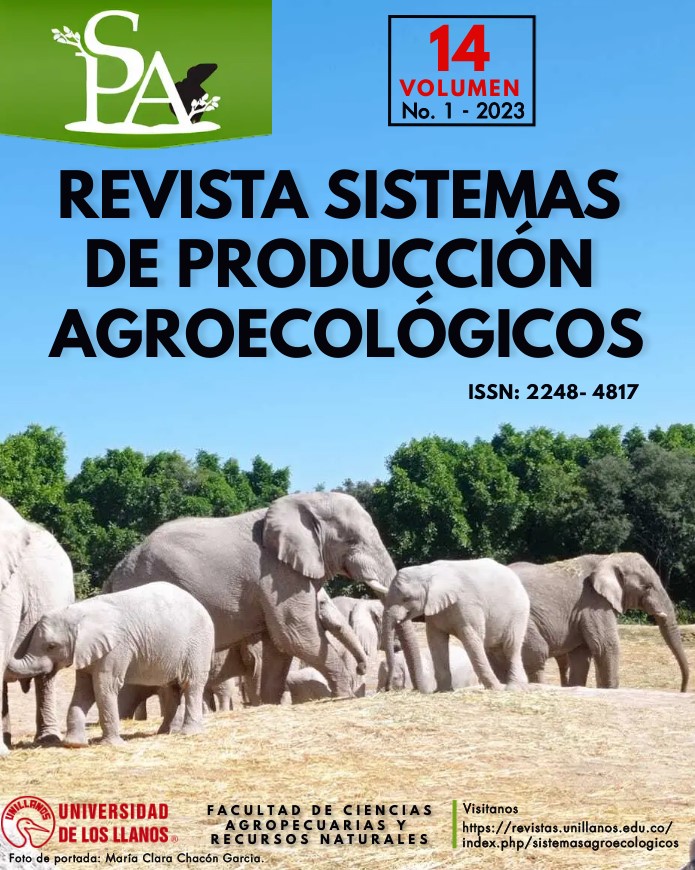Seguridad biológica y ensayo in vitro de expresión génica en PBMC de caninos vacunados experimentalmente contra Toxocara canis
Biological safety and in vitro gene expression assay in PBMC of canines experimentally vaccinated against Toxocara canis
Contenido principal del artículo
Resumen
La toxocariasis es una zoonosis desatendida de alta prevalencia e impacto en la salud pública de poblaciones empobrecidas del mundo, su agente causal es el nematodo del género Toxacara. Actualmente se utilizan antiparasitarios de amplio espectro para afrontar la enfermedad, sin embargo, no existe una vacuna para prevenirla. El objetivo de esta investigación fue evaluar la seguridad biológica de ensayos clínicos experimentales de vacunología inversa; y así mismo evaluar la respuesta in vitro de PBMC de caninos previamente vacunados con las proteínas recombinantes rTcVcan y rTcCad de Toxocara canis, a través del ensayo de expresión génica medida por RT-qPCR de citocinas IL-5, IL- 6, IL-17A, IL-10, TNF-α e INF-Ɣ. Como resultado, una vez realizados los ensayos clínicos para la vacunación de los cachorros, no se observaron diferencias con respecto a los rangos de referencia de los análisis de hematología, así como de los análisis de las funciones hepática y renal en los cachorros y; por otra parte, en los ensayos de expresión génica en PBMC, únicamente el gen ACTB se expresó con éxito, los genes referentes a las citocinas no presentaron resultados estadísticamente significativos. En conclusión, las formulaciones aplicadas no fueron tóxicas y no tuvieron efectos adversos en los animales experimentales y los ensayos de expresión génica en PBMC de los cachorros vacunados con las proteínas recombinantes rTcVcan y rTcCad contra T. canis no presentaron resultados concluyentes con respecto al éxito de estos procedimientos en la primera fase de la vacuna experimental.
Descargas
Detalles del artículo
Palabras clave
Referencias
Bowman DD. Helminths. Georgis’ Parasitology for Veterinarians E-Book. 2014. 10ma ed. Saunders, St. Louis, pp: 122–240.
Companion Animal Parasite Council (CAPC). Recommendations on Parasite Control Hookworms, 2016. Disponible en: https://www.capcvet.org/capc-recommendations/hookworms.
Chen J, Zhou DH, Nisbet AJ, Xu MJ, Huang SY, Li MW, et al. Advances in molecular identification, taxonomy, genetic variation and diagnosis of Toxocara spp. Infect Genet Evol. 2012; 12(7): 1344-1348. Doi: 10.1016/j.meegid.2012.04.019.
Dantas-Torres F. Toxocara prevalence in dogs and cats in Brazil. Adv Parasitol. 2020;109:715-741. Doi: 10.1016/bs.apar.2020.01.028.
de Díaz F & Anccasi M. Enteroparásitos en perros (Canis familiaris) y gatos (Felis catus) de la provincia de Puno. Rev. Investig. Altoandin. 2013; 15(1): 117-122.
Despommier D. Toxocariasis: clinical aspects, epidemiology, medical ecology, and molecular aspects. Clin Microbiol Rev. 2003; 16(2): 265-72. Doi: 10.1128/CMR.16.2.265-272.2003.
Dubucquoi S, Desreumaux P, Janin A, Klein O, Goldman M, Tavernier J, et al. Interleukin 5 synthesis by eosinophils: association with granules and immunoglobulin-dependent secretion. J Exp Med. 1994; 179(2):703-8. Doi: 10.1084/jem.179.2.703.
Elsemore DA, Geng J, Cote J, Hanna R, Lucio-Forster A, Bowman DD. Enzyme-linked immunosorbent assays for coproantigen detection of Ancylostoma caninum and Toxocara canis in dogs and Toxocara cati in cats. J Vet Diagn Invest. 2017; 29(5): 645-653. Doi: 10.1177/1040638717706098.
European Scientific Councel for Parasitosis in Companion Animals ESCCAP.
Worm Control in Dogs and Cats 1 (Sixth Edit, Issue February); 2020.
Fillaux J, Magnaval JF. Laboratory diagnosis of human toxocariasis. Vet Parasitol. 2013; 193(4): 327-336. Doi: 10.1016/j.vetpar.2012.12.028.
Gopal GJ, Kumar A. Strategies for the production of recombinant protein in Escherichia coli. Protein J. 2013; 32(6):419 - 425. Doi: 10.1007/s10930-013-9502-5.
Gorman T, Soto A, Alcaino H. Parasitismo gastrointestinal en perros de comunas de Santiago de diferente nivel socioeconómico. Parasitol. latinoam. [Internet]. 2006 Dic [citado 2023 Jul 29]; 61( 3-4 ): 126-132. Disponible en: http://www.scielo.cl/scielo.php?script=sci_arttext&pid=S0717-77122006000200005&lng=es.
Huang L, Appleton JA. Eosinophils in Helminth Infection: Defenders and Dupes. Trends Parasitol. 2016; 32(10):798-807. Doi: 10.1016/j.pt.2016.05.004.
Jaramillo-Hernández DA, Salazar LF, Baquero M, Pinheiro CS, Alcantara-Neves NM. Toxocariasis and Toxocara vaccine: a review. Revista Orinoquia, 2020; 24: 79-95.
Jaramillo-Hernández DA, Salazar Garcés LF, Pacheco LG, Pinheiro CS, Alcantara-Neves NM. Protective response mediated by immunization with recombinant proteins in a murine model of toxocariasis and canine infection by Toxocara canis. Vaccine. 2022; 40(6): 912-923. Doi: 10.1016/j.vaccine.2021.12.052.
Llanos M, Condori M, Ibáñez T & Loza M. Parasitósis entérica en caninos (Canis familiaris) en el área urbana de Coroico, Nor Yungas Departamento de La Paz, Bolivia. J. Selva Andina Res. Soc. [Internet]. 2010 [citado 2023 Jul 29]; 1( 1 ): 38-49. Disponible en:
http://www.scielo.org.bo/scielo.php?script=sci_arttext&pid=S2072-92942010000100005&lng=es.
Ma G, Holland CV, Wang T, Hofmann A, Fan CK, Hotez PJ, et al. Human toxocariasis. Lancet Infect Dis. 2018; 18(1):e14-e24. Doi: 10.1016/S1473-3099(17)30331-6.
Macpherson CN. The epidemiology and public health importance of toxocariasis: a zoonosis of global importance. Int. J. Parasitol. 2013; 43: 999-1008. Doi: 10.1016/j.ijpara.2013.07.004.
Maizels RM, Mcsorley HJ. Regulation of the host immune system by helminth parasites. J. Allergy Clin. Immunol. 2016; 138:666-675. Doi: 10.1016/j.jaci.2016.07.007.
Meeusen EN, Balic A. Do eosinophils have a role in the killing of helminth parasites? Parasitol Today. 2000; 16(3): 95-101. Doi: 10.1016/s0169-4758(99)01607-5.
National Research Council (NRC) US Committee for the Update of the Guide for the Care and Use of Laboratory Animals. Guide for the Care and Use of Laboratory Animals. 2011. 8th ed. Washington (DC): National Academies Press (USA).
Nielsen J. Production of biopharmaceutical proteins by yeast: advances through metabolic engineering. Bioengineered. 2013; 4(4):207 - 211. Doi: 10.4161/bioe.22856.
Pinelli E, Aranzamendi C. Toxocara infection and its association with allergic manifestations. Endocr Metab Immune Disord Drug Targets. 2012; 12(1): 33-44. Doi: 10.2174/187153012799278956.
Ramírez-Barrios RA, Barboza-Mena G, Muñoz J, Angulo-Cubillán F, Hernández E, González F, et al. Prevalence of intestinal parasites in dogs under veterinary care in Maracaibo, Venezuela. Vet Parasitol. 2004; 121(1-2):11-20. Doi: 10.1016/j.vetpar.2004.02.024.
Regis SC, Mendonça LR, Silva S, Dattoli VC, Alcântara-Neves NM, Barrouin-Melo SM. Seroprevalence and risk factors for canine toxocariasis by detection of specific IgG as a marker of infection in dogs from Salvador, Brazil. Acta Trop. 2011; 120(1-2): 46-51. Doi: 10.1016/j.actatropica.2011.05.011.
Resende NM, Gazzinelli-Guimarães PH, Barbosa FS, Oliveira LM, Nogueira DS, Gazzinelli-Guimarães AC, et al. New insights into the immunopathology of early Toxocara canis infection in mice. Parasit Vectors. 2015; 8:354. Doi: 10.1186/s13071-015-0962-7.
Rostami A, Ma G, Wang T, Koehler AV, Hofmann A, Chang BCH, et al. Human toxocariasis - A look at a neglected disease through an epidemiological 'prism'. Infect Genet Evol. 2019; 74:104002. Doi: 10.1016/j.meegid.2019.104002.
Rubinsky-Elephant G. Human toxocariasis: Humoral response (IgG, IgA and IgE) anti-Toxocara canis and clinical-laboratorial correlation in patients following chemotherapy. Rev Ins Med Trop São Paulo. 2004; 46: 76-81.
Ruiz-Manzano RA, Hernández-Cervantes R, Del Río-Araiza VH, Palacios-Arreola MI, Nava-Castro KE, Morales-Montor J. Immune response to chronic Toxocara canis infection in a mice model. Parasite Immunol. 2019; 41(12):e12672. Doi: 10.1111/pim.12672.
Salazar LF, Santiago LF, Santos SPO, Jaramillo-Hernández DA, da Silva MB, Alves VDS, et al. Immunogenicity and protection induced by recombinant Toxocara canis proteins in a murine model of toxocariasis. Vaccine. 2020; 38(30): 4762-4772. Doi: 10.1016/j.vaccine.2020.04.072.
Sarmiento-Rubiano LA, Delgado L, Ruiz JP, Sarmiento MC, Becerra J. Parásitos intestinales en perros y gatos con dueño de la ciudad de Barranquilla, Colombia. Rev. investig. vet. Perú [Internet]. 2018 Oct [citado 2023 Jul 29]; 29(4): 1403-1410|. Disponible en: http://www.scielo.org.pe/scielo.php?script=sci_arttext&pid=S1609-91172018000400036&lng=es.
Schwartz R, Bidaisee S, Fields PJ, Macpherson MLA, Macpherson CNL. The epidemiology and control of Toxocara canis in puppies. Parasite Epidemiol Control. 2022; 16:e00232. Doi: 10.1016/j.parepi.2021.e00232.
Sugane K, Kusama Y, Takamoto M, Tominaga A, Takatsu K. Eosinophilia, IL-5 level and recovery of larvae in IL-5 transgenic mice infected with Toxocara canis. J. Helminthol. 1996; 70(2):153-158. Doi: 10.1017/s0022149x00015315.
Takamoto M, Wang ZX, Watanabe N, Matsuzawa A, Nariuchi H, Sugane K. Eosinophilia, IgE production, and cytokine production by lung T cells in surface CD4-deficient mutant mice infected with Toxocara canis. Immunology. 1998; 95(1):97-104. Doi: 10.1046/j.1365-2567.1998.00575.x.
Torina A, Caracappa S, Barera A, Dieli F, Sireci G, Genchi C, et al. Toxocara canis infection induces antigen-specific IL-10 and IFNgamma production in pregnant dogs and their puppies. Vet Immunol Immunopathol. 2005; 108 (1-2): 247-251. Doi: 10.1016/j.vetimm.2005.08.006.
Traversa D, Joachim A. The 3Rs Concept: Time to Change How We Evaluate the Efficacy of Anthelmintics in Companion Animals. Trends Parasitol. 2018; 34(1): 41-52. Doi: 10.1016/j.pt.2017.09.002.
Valli JL, Williamson A, Sharif S, Rice J, Shewen PE. In vitro cytokine responses of peripheral blood mononuclear cells from healthy dogs to distemper virus, Malassezia and Toxocara. Vet Immunol Immunopathol. 2010; 134(3-4):218-29. Doi: 10.1016/j.vetimm.2009.09.023.
Zibaei M, Shayesteh Z, Moradi N, Bahadory S. Human Toxocara Infection: Allergy and Immune Responses. Antiinflamm Antiallergy Agents Med Chem. 2019; 18(2):82-90. Doi: 10.2174/1871523018666181210115840.


 PDF
PDF
 FLIP
FLIP








